haptic reactor
AFR Series / AFDU Series
Use of touch panel controls exploded with the emergence of smartphones and now that hierarchical apps have made it possible to operate diverse functions, touch technology has spread beyond mobile devices into the automotive and industrial domains.
But whereas mechanical switches, previously the main form of control, used a click sensation to convey the completion of an action to the user, touch panel feedback consists of screen changes or sound. Depending on the circumstances, it can sometimes be hard to convey feedback to the user. Alps Alpine, a switch manufacturer, responded by developing the haptic reactor, ideal for enabling tactile feedback (haptics) even with touch controls.
However, automotive, or industrial, equipment and mobile devices are different in terms of size and usage environments, creating demand for devices that deliver tactile feedback with a stronger vibration force.
The haptic reactor AFR Series delivers feedback for touch control of automotive and industrial equipment using strong, distinct vibrations.
The newly developed haptic reactor AFDU Series is a compact version of the AFR Series and can be used not only in-vehicle but also for various applications.
Basic Operating Principles of the haptic reactor AFR Series / AFDU Series
Installed on the underside of a touch panel, the haptic reactor AFR Series / AFDU Series vibrates in a horizontal direction relative to the panel. Sensory receptors in human fingertips tend to falsely perceive horizontal displacement as unevenness (lateral force field phenomenon), conveying a click sensation, like the push of a mechanical switch, to the user's finger.
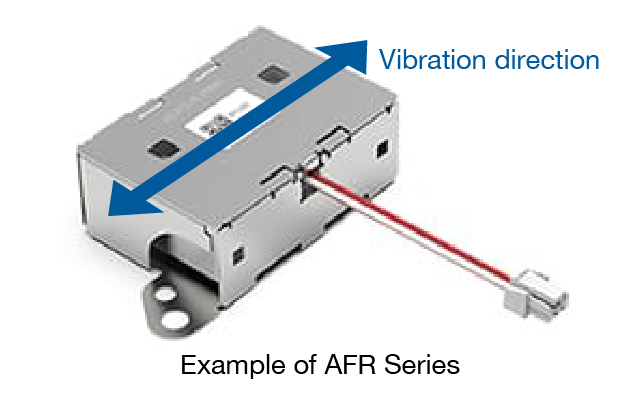
Here we explain the basic principles of vibration for the haptic reactor AFR Series / AFDU Series using simplified diagrams illustrating electromagnetic force and the internal structure.
Electromagnetic Force
Electromagnetic force occurs when a conductor is placed in a magnetic field and a current flows through it. The force acts on the conductor in a direction orthogonal to both the magnetic field and the current. Fleming's left hand rule (see below) illustrates the direction of this force.
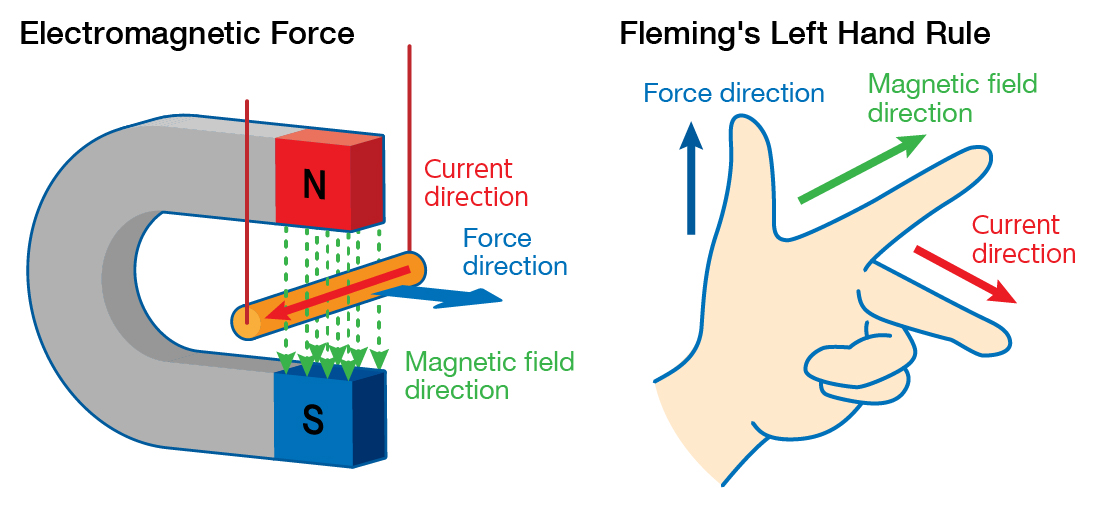
Basic Operating principles of the haptic reactor (example of AFR Series)
The mover is elastically suspended by springs, while the coil is fixed so it does not move.
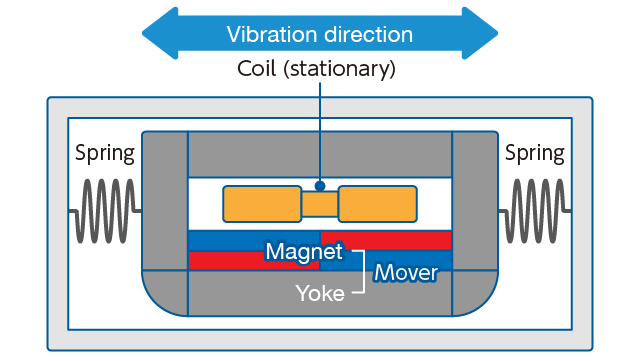
Electromagnetic force is generated as current flows through the coil in the direction indicated in the diagram on the right. However, because the coil is fixed in place and the magnet suspended elastically by springs, the mover reacts by moving to the right, in the direction opposite to Fleming's left hand rule.
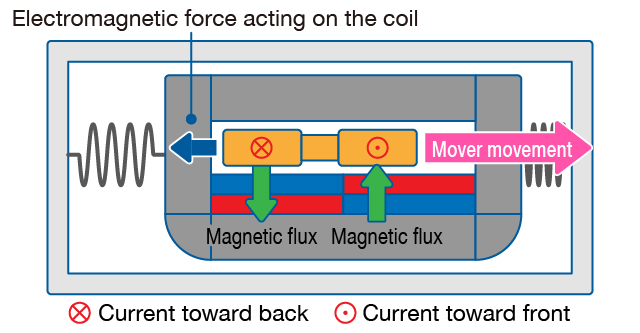
Reverse the current so it flows in the opposite direction to STEP 2 and the mover moves to the left.
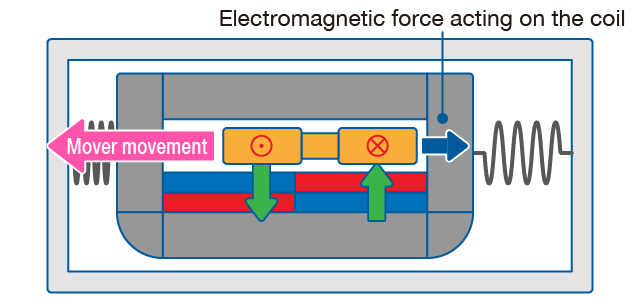
Repeating STEP 2 and STEP 3 generates horizontal vibration as the mover repeatedly moves left and right.
Vibration Force of the haptic reactor (example of AFR Series)
Innovation of the magnetic circuit configuration means the haptic reactor AFR Series generates a vibration force of 15G*, five times our existing AFT Series.
* Drive voltage: 6Vp-p (20 sine waves)
See the vibration force for yourself in this video. A single haptic reactor AFR Series is conveying vibrations to the water surface and polystyrene balls. You can see the vibrations spreading throughout.
Comparison Between haptic reactor AFR Series / AFDU Series and Competing Technologies
The following is a comparison between the haptic reactor AFR Series / AFDU Series and competing feedback devices. Features of the haptic reactor AFR Series are its vibration strength, making use of resonance, and its ease of mounting.
In addition, the newly developed haptic reactor AFDU Series features a balance of size and vibration force.
| haptic reactor AFR Series |
haptic reactor AFDU Series |
SOLENOID | ERM | PIEZO | |
|---|---|---|---|---|---|
| Picture |  |
 |
 |
 |
 |
| Size | ★★ | ★★★ | ★ | ★★ | ★★★ |
| Drive voltage | ★★ | ★★ | ★★ | ★★ | ★ |
| Vibration strength | ★★★★ | ★★★ | ★★ | ★★ | ★★ |
| Responsiveness | ★★ | ★★ | ★★★ | ★ | ★★★ |
| Power consumption | ★★★ | ★★★ | ★ | ★ | ★★ |
| Expression | ★ | ★ | ★ | ★ | ★★★ |
| Mounting | ★★★ | ★★★ | ★★ | ★★ | ★ |
| Features |
|
|
|
|
|
Eccentric rotating mass (ERM) motor: Generates vibrations using the centrifugal force created by a rotating mass
Piezo (piezoelectric device): Makes use of ceramic material that distorts with the application of voltage
- Caution
- Alps Alpine owns patents relating to the structure of this product, but we ask customers to check patents for applications and usage methods.
Past articles
-

Understanding TACT Switch™ Product Specifications
April, 2025 -

Characteristics Produced by TACT Switch™ Metal Contacts
April, 2024 -

haptic reactor AFR Series / AFDU Series
March, 2024 -

Achromatic Lenses
March, 2023 -

TACT Switch™ Products with a Long Service Life
May, 2022 -

Internal Resistor Type Detector Switches
November, 2021 -

Features of Force Sensors
March, 2021 -

Air Pressure and Water Pressure Sensors
February, 2021 -

Pressure Sensors
January, 2021 -

haptic reactor AFT Series
November, 2020 -

TACT Switch™ – Realizing Quiet Operation
October, 2020 -

TACT Switch™ – Features and Effects of Middle-Stroke Types
September, 2020 -

TACT Switch™ – Middle-Stroke Types
July, 2020 -

Stick Controllers (ThumbPointer™)
May, 2020 -

Encoders
April, 2020 -

Potentiometer Varieties
March, 2020 -

Potentiometers – What Are They?
February, 2020 -

Alps Alpine's Humidity Sensors
January, 2020 -

Features of Spring Contacts
September, 2019 -

Spring Contacts – What Are They?
August, 2019 -

Features of Slide Switches
July, 2019 -

Detector Switch Varieties
July, 2019 -

A Special Feature of Detector Switches
June, 2019 -

Features of Resistive Position Sensors
April, 2019 -

Resistive Position Sensors
April, 2019 -

Angle Sensor
November, 2018 -

2-in-1 Encoder with Variable Magnetic Pole Pitch
October, 2018 -

Magnetic Sensor
September, 2018 -

TACT Switch™ as a Multifunctional Key
July, 2018 -

Factors Determining the Feel of a Switch
June, 2018 -

Having Trouble with Contamination of Electrical Contacts?
May, 2018